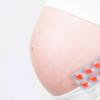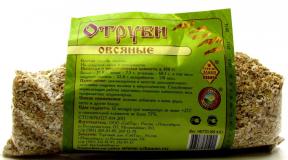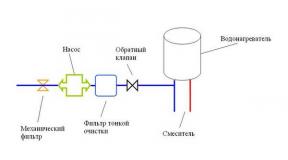Treatment and prevention of chronic venous insufficiency. Chronic venous lack of lower limbs. Important moments of therapy
Venous failure of the legs is the most frequent disease peripheral vessels. The limbs occurs in stagnation, the valves weaken, do not perform the role of the pressure regulator.
It should be distinguished that venous insufficiency and varicose veins are not the same. Varicosis is the cause, and sometimes the symptom of insufficiency.
Principle of development of the disease
 Vienna distinguish deep and subcutaneous surface. The bulk of blood from lower extremities, about 80-90%, proceeds in a deep venous system.
Vienna distinguish deep and subcutaneous surface. The bulk of blood from lower extremities, about 80-90%, proceeds in a deep venous system.
The walls of the surface veins have smooth muscle fibers, helping blood stream.
The flow of blood in deep veins provides a set of factors:
- intra-abdominal pressure;
- venous-muscular pump, working with muscle contraction - provides pumping of the main volume (about 75%) blood;
- breathing, and as a result of this - the movement of the diaphragm;
- pressing the plantar venous system when walking;
- arterial pressurewhich affects the origins venous blood;
The blood flow also depends on the position of the person in space.
For horizontal position It happens passively. In the vertical flow of blood to the heart is provided by a muscular venous pump.
With a weakening of the system of valves and the resulting venous hypertension, blood outflow is broken. The venous failure of the lower extremities is developing.
The reasons
 Aries arises suddenly and can be caused by deep veins thrombosis, drug, food or chemical poisoning. It is possible as a result of a violation of blood coagulation or severe diseases, such as cirrhosis of the liver.
Aries arises suddenly and can be caused by deep veins thrombosis, drug, food or chemical poisoning. It is possible as a result of a violation of blood coagulation or severe diseases, such as cirrhosis of the liver.
Chronic venous insufficiency often proceeds hidden, without expressed symptoms.
Many reasons lead to the disease:
- insufficient physical activity;
- long static positions standing or sitting, due to the characteristics of the profession. Cashier, seller, conveyor worker or office employee;
- excess weight;
- vibrations of hormonal background, estrogen ratio and progesterone in women;
- pregnancy - the growing uterus squeezes the veins of the peritoneum, contributes to the increase in pressure in venous vessels;
- heavy exercise - lifting weights, classes by some sports - struggle, rod rise, pushing the kernel;
- heredity - congenital weakness of vessels and valves;
- varicose, thrombophlebitis.
 And Aries, and the HSDs can develop as a result of injury to the veins, its squeezing (with the growth of tumors, for example) or overlapping the lumen of the veins with a clutch of blood.
And Aries, and the HSDs can develop as a result of injury to the veins, its squeezing (with the growth of tumors, for example) or overlapping the lumen of the veins with a clutch of blood.
Classification of acute and chronic form. Stages and degrees
According to the domestic classification, the VN is divided into 4 degrees:
- 0 - At this stage there are no symptoms, but the patient has a predisposition and a set of provoking factors.
- 1 - there is a swelling and heaviness in the legs.
- 2 - This degree is characterized by the pigmentation of the skin, non-coming edema, eczema, lipodertosclerosis.
- 3 - appearance trophic Yazv.
The international CEAP system classifies VN on clinical features, due to the occurrence of pathology, at the place of defeat.
Degree
Cipher consists of large and small latin letters and Arabic numbers. The letter C denote the class of disease in clinical features.
Degrees VN P. clinical classification CEAP:
- C0 - Visual inspection and palpation do not allow to detect the symptoms of the disease.
- C1 - observed vascular stars and expanding thin subcutaneous veins.
- C2 - Varicosis is diagnosed.
- C3 - swelling appears;
- C4A - the skin is pigmented, venous eczema appear;
- C4B - the skin is compacted, excessive pigmentation or white skin atrophy begins;
- C5 - In addition to pigmentation, self-healing wounds are observed;
- C6 - Open trophic ulcers and related skin changes.
 The E index is assigned due to the occurrence (etiology):
The E index is assigned due to the occurrence (etiology):
- EC - VN developed due to hereditary inclination;
- Ep - the reason remained unexplained;
- ES - the reason is established - consequences of injury, varicose extension.
Letter A Indicates the area of \u200b\u200bthe lesion (anatomical classification):
- AS - the disease has touched the surface veins;
- AP is the defeat of communicable (connecting) veins;
- AD - Pathology of deep veins;
- An - visible changes are not detected.
Index P The disease is grouped by the type of lesion (pathophysiological basis):
- PR - damage to the valves;
- Po - full overlap of the lumen of veins (occlusion);
- PR, O - a combination of both pathologies;
- PN - outflow violations are not installed.
The cipher includes numbers from 1 to 18, which indicate the site of the venous system. There may be several of them.
Based on the symptoms, the patient's performance is established, and is described by stages from 0 to 3.
 The zero stage is assigned to patients without expressed symptoms and complaints. The performance is completely saved.
The zero stage is assigned to patients without expressed symptoms and complaints. The performance is completely saved.
At the first stage, the first signs of pathology are noted, efficiency is preserved, the reception of drugs is not required.
At the second stage, performance is preserved due to drug support.
The third stage is characterized by loss of performance even with supporting therapy.
Symptoms
Signs of Aries
Aries almost half of the cases proceeds asymptomatic. The only sign of the venous insufficiency of the lower extremities becomes the pulmonary thromboembolism - the patient threatens a fatal outcome.
In other cases, the symptoms of venous insufficiency of the lower extremities are rapidly increasing and necessary for urgent treatment.
The limb swells, the pain appears, amplifying when driving. The pain is growing to unbearable, gives to the genitals. Skin covers are pale, then blue.
Leg temperature drops a few degrees. In contrast to the body temperature, which rises to 40 C.
Signs of Hyd.
 The diagnosis of helms accompanies the varicose veins and swelling of the stop and tibia. This type of pathology amazes, mainly superficial veins.
The diagnosis of helms accompanies the varicose veins and swelling of the stop and tibia. This type of pathology amazes, mainly superficial veins.
At the beginning of the disease, swelling takes place after a night sleep or long rest in a horizontal position.
The usual shoes becomes a little, the patient has discomfort when walking, in the morning heavily step on his feet. There is a severity in the legs, cramps and pain.
Pathology is accompanied by headaches, fainting, shortness, rapid heartbeat.
Diagnosis of pathology
Perform instrumental and laboratory studies.
Investigate blood on the tendency to thrombosis, estimating its characteristics according to the general and biochemical analysis.
With the help of ultrasound, a duplex vessel scan is carried out. This method allows you to estimate the condition of the walls of the vessels, their worniness and track the nature of blood flow.
Using x-ray research is carried out phlebography. The veins introduce a contrast agent to assess the state of the vessels and blood flow. Definitions of the lesion section, its duration.
Recently, phlebography is performed much less often due to the traumatic method of the method.
Treatment
 Aries are treated conservative and surgical methods. There are three trends:
Aries are treated conservative and surgical methods. There are three trends:
- medicate. Anticoagulants are prescribed, antiagregants, nonsteroidal anti-inflammatory agents. Venotonics outdoor I. internal application, hormonal drugs from group glucocorticoids. Essence medical treatment It is to restore blood flow, blood dilution, the elimination of inflammation;
- compression. This method is used regardless of the shape, causes and stages of VN. Properly selected compression bandage contributes to the return of blood to the heart. Healing trophic ulcers, normalization of pressure inside vessels. Distinguish several degrees of subtletable pressure from very easy to very strong;
- surgical. It may be thrombolysis or thrombectomy aimed at dissolving blood thrombus in Vienna. Restoration of blood flow and integrity of venous vessels.
If the diagnosis of acute venous insufficiency is diagnosed, the first thing you need to do is lie. Set the leg above the chest level and attach a cold compress.
The main difference in the treatment of Aries from the chronic form is to limit the mobility of the patient.
Treatment of chronic form of the disease
Medicate
 For internal use prescribed drugs of the following groups:
For internal use prescribed drugs of the following groups:
- nonteroidal anti-inflammatory means - eliminate inflammatory processwhich has no infectious nature, relieve pain and spasm;
- glucocorticosteroids - accelerate the process of healing and recovery, contribute to the elimination of inflammation;
- anticoagulants - contribute to blood dilution;
- antiagregants - prevent sticking of erythrocytes, which helps prevent thrombosis;
- preparations against ischemia - nourish cells under oxygen fasting conditions;
- antiallergic means - reduce the likelihood of immune response to products exchange processes;
- antibacterial drugs - aimed at the prevention of infectious damage.
Outwardly apply:
- ointment and cream based on hormonal substances;
- antiseptics;
- venotonics.
Surgical
 The methods of surgical treatment of HSN are quite diverse:
The methods of surgical treatment of HSN are quite diverse:
- sclerotherapy is used to glue small and medium veins;
- laser surgery. Use for healing trophic ulcers and removing sore veins under the control of ultrasound. Which are eliminated from the inside with a laser beam. To do this, through the puncture in the skin, the light guide is introduced and through it affects the affected area;
- surgical removal of varicose extended veins. Intervention is carried out under general anesthesia To remove large diameter vessels;
- ablation. It is used to remove varicose veins. They introduce a catheter with heating elements at the end. With their help, patients with vessels are migrated;
- phlebectomy. Conducted under local anesthesia. The essence of treatment is to remove the veins of a small diameter;
- endoscopic removal of veins. This method is used in the appearance of skin defects, its ulcerations. The damaged vessel is removed during visual control over the passage of the operation;
- veins shunt - install an artificial vessel for the restoration of blood flow bypassing the damaged area;
- restoring valve functioning.
Compression therapy
 Apply a compression bandage in the form of elastic bandages, therapeutic knitwear or treatment with intermittent pneumatic compression devices.
Apply a compression bandage in the form of elastic bandages, therapeutic knitwear or treatment with intermittent pneumatic compression devices.
Most often, they are bypass with therapeutic bandages or wearing knitwear.
Appoints underwear or bandages Doctor according to the degree of vessel damage and general status patient.
Auxiliary therapy by folk methods
Treatment of venous insufficiency by folk remedies is auxiliary. It is to dilute the blood and the restoration of the tone of venous vessels.
The leader among all plants for the treatment of veins of veins - horse chestnut. A hundred grams of crushed chestnut fruits requires 500 ml of alcohol.
The tool insists in a dark place for a month. Use for half an hour before eating 10 ml of tincture, divorced in a small amount of water.
The tincture is used for rubbing and compresses.
The root of Aira Bolotnaya is useful. Dry rhizome is crushed, aquatic tincture is prepared from it. Half of the teaspoon of raw materials insisted in a glass of boiling water before cooling.
Drink three times a day.
The root of Aira insists 10-14 days in natural apple vinegar. 50 g root per 500 ml of vinegar.
Take 2 tablespoons of tincture 2 times a day.
 Preventive measures are to maintain optimal body weight and sufficient physical activity.
Preventive measures are to maintain optimal body weight and sufficient physical activity.
Helps to avoid disease proper nutrition and a healthy lifestyle.
It should be abandoned by bad habits, especially smoking.
The food must be taken in small portions, 4-5 times a day.
Of great importance is the drinking mode - per day you need to drink up to 2.5 liters of pure water.
Useful video: venous failure
Venous insufficiency is a symptom complex due to a violation of blood outflow on the venous system. About 40% of adults suffer from this pathology. More often observed venous lack of lower extremities. This is explained by the lifelongness of man, as a result of which the load on the leg veins is significantly increasing, as the blood flows over them, overcoming gravity forces. Venous failure can be observed in other parts of the body - internal organs, brain.
Will swelling in venous lack of lower extremities
Chronic venous insufficiency - slowly progressive pathology, which is practically asymptomatic for a long time, because of which patients are treated for medical help Often already in running stages. This lies in the cunning of the disease. According to statistics, no more than 8-10% of patients receive treatment timely treatment.
Chronic venous insufficiency - slowly progressive pathology, which is practically asymptomatic for a long time. According to statistics, no more than 8-10% of patients receive treatment timely treatment.
Differential diagnosis is carried out with lymphangitis, silent inflammation. Acute venous insufficiency differentiate with stretching or gap of muscles, squeezing the veins from the outside enlarged lymphatic nodes or a tumor, lymphydable, bayer cyst, cellulite.
Treatment of venous insufficiency
Treatment of acute venous insufficiency is beginning with the imposition of a cold compression on the affected limb. For this, cotton tissue is wetted in ice water, pressed and superimposed on the skin. After 1.5-2 minutes, the fabric is removed and wetting it in water, and then overlap on the skin. The total duration of the procedure is one hour.
Patients provide a strict bed mode. In order to prevent further thrombosis, heparin injections are prescribed, which are performed under the control of blood coagulation time and the number of platelets. Further shown indirect anticoagulants. In the first days of therapy, the prothrombin index is determined daily, in the future it is monitored once in 7-10 days for several weeks, and after stabilizing the patient's condition - once a month during the entire treatment.
With acute venous insufficiency of the lower limbs caused by the formation of floting thrombus, surgery is shown, which consists in installing a Kava filter in the lower vein below the renal vein level. This operation prevents the development of thromboembolic complications, including potentially dangerous patient for the patient of the pulmonary artery (TEL).

Therapy of chronic venous insufficiency, as a systemic pathological process, is directed not only to the restoration of normal venous blood flow, but also to prevent recurrence of the disease.
Medical treatment of venous insufficiency in its chronic form is carried out by drugs that reduce blood coagulation (acetylsalicylic acid, indirect anticoagulants) and phlebotropic means. In addition to drug therapy, an elastic compression method is used (the binting of the limb to elastic bandages, wearing a compression knitwear).
Often, patients are confused by varicose veins and venous lack of lower limbs. These two pathologies have a lot in symptoms, but still are not identical.
In chronic venous insufficiency according to the testimony, surgical removal of varicose veins performs, or replace the operation of sclerosing therapy - in the pathologically modified vein introduced a special drug Treatmentwhich causes inflammation of its walls, and in the future their sticking together.
Possible consequences and complications
Complications of chronic venous insufficiency are:
- thrombophlebitis deep veins;
- pulmonary embolism;
- streptococcal lymphangitis.
Acute venous insufficiency can cause the development of white or blue pain phlegmascus, which, in turn, can lead to the limb gangrene, hypovolemic shock (due to a significant blood deposit in the limb). Another complication of this state may become purulent melts of thrombus, with the development of abscess, phlegmon, and in the most severe cases even septicopemia.
Chronic venous brain deficiency leads to, causes irreversible changes in the nervous tissue, can cause a resistance of disability.
Forecast
With timely diagnosis and active treatment of venous insufficiency, the forecast is generally favorable.
Prevention
Prevention of acute venous insufficiency includes:
- early activation of patients after surgical interventions;
- the use of elastic stockings;
- performing patients with periodic tibia compression;
- medicinal prevention of thrombosis during its increased risk.
Preventive measures aimed at preventing the formation of chronic venous insufficiency:
- prevention of constipation;
- active lifestyle (sports, outdoor walking, morning gymnastics);
- avoiding long stay in static position (seat, standing);
- when conducting replacement hormone therapy, estrogen women recommend that elastic stocking, regularly control the prothrombin index;
- refusal to carry tightening linen, outerwear with a tough collar;
- overweight;
- refusal to regularly wearing high-heeled shoes.
Video from YouTube on the subject of Articles:
Venous insufficiency is a condition in which the veins cannot transport blood from the limbs to the heart in sufficient volumes. The venous insufficiency of the lower extremities - the symptoms of it are familiar with men and women, and the treatment gives difficulties even to specialists.

The most common symptom is a stupid pain in the legs, which becomes unbearable by the end of the day. Painfulness Strengthen after a long standing position. The symptoms are caused by the stagnation of venous blood in the legs, which leads to the edema. It causes swelling, tingling and even cramps.
The skin becomes pale, and then blushes and looks brown-red. In the ankles, the limb is increasing in volumes, itching joins. If venous insufficiency is associated with the expansion of the veins, they become noticeable, as they acquire blue and become convex.
Then the trophic disorders progress, the skin looks scaly and covered with ulcers. The patient accompanies the gravity of the legs and noticeable swelling.
Venous insufficiency develops in the absence of proper blood circulation in the limbs. Circulation does not occur because blood blocks of veins or valve failure interferes bleed. As a result, blood begins to gather in the lower limbs. The venous valve apparatus serves to refer blood flow to the right channel (to heart). If the valves are damaged, some of the blood remains in the lower limbs. Other reasons:
- Formation of thrombus in deep veins;
- Varicose veins;
- Blood clots that prevent blood flow;
- Age older 50;
- Progesterone oscillation associated with pregnancy;
- Excess weight;
- Sedentary work;
- Muscle weakness;
- Oncological diseases;
- Injuries;
- Genetic anomalies;
- Smoking.
Venous insufficiency is diagnosed by a doctor during a visual inspection. Additional method - The use of Doppler ultrasound research. The survey shows defects of valves, blood clots, dimensions and shape of the vessel. To clarify the diagnosis, MRI or tomography is used.

Treatment of venous lack of lower extremities
The most disturbing symptoms are pain and swelling. Therefore, treatment primarily consists of the relief of these signs.
Medical treatment - receiving funds that dilute blood. Anticoagulants dissolve blood clots and restore the vessel's passability. Preparations also warn the formation of thromboms.
Medical preparations for the treatment of venous insufficiency:
- Avenue - the drug increases the tone of the vascular wall, increases lymphatic outflow, reduce the brittleness and capillary permeability.
- Detralex - protects the vascular wall from damage, veins tones.
- Eskusan - a preparation made from horse chestnut. Increases the production of catecholamines, protects veins from damage, increases the elasticity of the vascular wall.
- Venarus - improves circulation and venous outflow.
- Phlebodia - promotes venous blood flow, reduces leg edema.
Such action possess: Laminin, Bilobil, Normoven.
Compression clothing - the mechanism of action is due to mechanical pressure on the vessels, which pushes blood in the right direction. They are located in a pharmacy and are available to everyone. They differ in size, color and material. Compression stockings are characterized by a compression gradient.
Medical bandages for the treatment of trophic ulcers - use antiseptics, ointments, folk remedies. Cold compresses are used for the treatment of acute stage - chilled gauze tampon is applied to the affected area for two minutes, then they are cooled again in ice tanks. The procedure is carried out for 40 minutes.
Non-surgical treatments
Endovenous thermal ablation is an effective and painless procedure for the treatment of venous insufficiency. Perched with a laser and high-frequency radio waves. It warns the progression of the disease.
 The method is to introduce a sclerosing solution into a vein that fills the extension and causes the vessel bonding. This eliminates pain and swelling. The drug is independently excreted from the body. In the early stages, the technique gives positive results no worse than after surgery. In more launched cases, combined treatment is necessary: \u200b\u200bsurgical, drug and physiotherapy.
The method is to introduce a sclerosing solution into a vein that fills the extension and causes the vessel bonding. This eliminates pain and swelling. The drug is independently excreted from the body. In the early stages, the technique gives positive results no worse than after surgery. In more launched cases, combined treatment is necessary: \u200b\u200bsurgical, drug and physiotherapy.
Benefits of sclerotherapy:
- There is no scarring;
- The integrity of the vein is maintained;
- Well tolerated psychologically;
- It is convenient to apply in chronic varicose veins;
- It can be prescribed in combination with other methods of treatment.
Surgical treatment of venous deficiency: bypass venous shunting - elimination of a change with transplantation healthy plot vessel.
Ligation and cleaning
 Surgical procedure consists in the firmware of the affected area and cleaning varicose nodes. Through the skin, with the help of a special tool, loops (ligatures) are superimposed, the seams are tied outside. After cutting the vessel, the thrombus is removed. The lack of a method is possible to recur.
Surgical procedure consists in the firmware of the affected area and cleaning varicose nodes. Through the skin, with the help of a special tool, loops (ligatures) are superimposed, the seams are tied outside. After cutting the vessel, the thrombus is removed. The lack of a method is possible to recur.
Phlebectomy - removal of blood clot and affected vein plot. Microcomputer intervention is performed through the skin in outpatient conditions. Modern methods: Laser phlebectomy and radio frequency obliteration.
Chronic venous lack of lower extremities
A long disturbance of venous blood outflow and the development of venous obstruction leads to chronic venous insufficiency. The pathogenesis is associated with the destruction of the valves with thrombosis, phlebitis, injuries and burns. The weakening of the muscle force, which is necessary for creating sufficient blood pressure, is not the immediate cause of chronic venous insufficiency, but contributes to the exacerbation of the disease.
Chronic venous insufficiency: clinical models
Symptoms of chronic venous insufficiency are grouped into the most common clinical options:
- Uncomplicated venous varicose veins;
- Superficial thrombophlebitis;
- Varicose disease is a generalized damage to vessels in combination with pain, eductions and skin changes. Often the cause is the pathology of superficial veins, the treatment of which will help to correct the situation;
- Syndrome of venous hypertension - pain in the legs when standing. In a sitting position, the pain passes. Sometimes, this is the only sign. Patients - young women. Reason in deep vest obstruction, surgery Removes pain.
- Edema extremities - arises in the elderly people who lead a low-wear lifestyle. More often found in women.
- A complex of multisystem venous pathologies is a violation in the system of surface, deep and perforative veins.
Chronic venous insufficiency is diagnosed with anamnestic data, external objective examination. Duplex ultrasound procedure Allows you to set the stage of the disease and expose or refute the presence of venous thrombosis. Other methods: Ventiosity, CT, MR-angiography.
Minor veins damage can occur without symptoms. On the other hand, the pathology of deep veins, as well as a combination with a disturbance of the outflow from superficial, leads to difficult consequences. Another factor causing peeling, disruption of capillary circulation, stagnation of lymph and a decrease in sensitivity - high blood pressure. Symptoms of chronic venous insufficiency are as follows:

Trophic venous ulcers are difficult to cure, they progress and give relapses. Factors of risk of exacerbation of venous ulcers:
- Post-commobotic symptom;
- Blockage in the ileal-femoral system;
- Insufficiency of deep veins;
- Resistant venous hypertension.
Development chronic insufficiency Depends on the rate of progression of the disease.
Chronic venous insufficiency: Prevention
Moving lifestyle, exercise aimed at strengthening the leg muscles is a great way to prevent venous insufficiency. Physical exercise We should not be static, they need to alternate with dynamic (running, swimming). Daily walking for 40 minutes will strengthen the muscles and the venous wall.
In the lying position, the legs should be kept in the sublime state. It should be borne in mind that overweight increases the load on the venous system, it makes it difficult to outflow from the limbs. High heel also interferes with the venous system freely move blood in vessels.
Using oral contraceptives - Risk of development of venous insufficiency. In this case, it should be regularly (twice / year) to pass the ultrasound vessels of the legs. The same measures must be used pregnant. If necessary, you need to use compression stockings.
The term "venous insufficiency" enjoy in medicine to indicate the mechanism of pathological changes. Any disease is suitable for it, associated with a violation of the influx of venous blood to the right heads of the heart. Statistics shows that different forms This disease suffers to 40% of the population.
It is impossible to "blame" only the structure of the veins. A variety of factors can be hidden. More understandable separation into venous insufficiency as a consequence of general insufficiency of blood circulation and local stagnation in peripheral vessels. At the same time, the "equally extreme" is considered as veins of the lower extremities and the brain.
Chronic or acute venous insufficiency is accompanied by stagnation and overflow of the venous bed, squeezing the adjacent tissues, oxygen deficiency of organs and systems.
Main pathological changes
It is known that venous vessels of most body constantly work against gravity strength. They push blood towards upwards when a person is in vertical position. For this wall veins, sufficient muscular tone and elasticity have.
Of great importance is attached to the valve apparatus, due to which the mass of blood is retained from return to the lower departments.
Local changes in venous vessels most often occur in the legs. Due to the loss of tone, the wires of the valves are liquid and thick parts of the blood overwhelm. A portion of the reverse flow skipped with valves is called the reflux value and determines the degree of violation of the function of the veins.
International classification considers signs of venous insufficiency for the reasons of occurrence:
- insufficiency as a consequence of injury, thrombosis and other identified diseases;
- genetic predisposition;
- specific reason is not installed.
According to the anatomical localization of the affected vessels:
- a specific vein is called, for example, the lower hollow or large subcutaneous;
- the level and depth of the lesion (superficial, deep or internal anastomoses) are designated.
Clinical manifestations on the limbs
Depending on the clinical signs It is customary to allocate 6 types or stages of the disease:
- the visible signs of the pathology of the veins are missing;
- there are extended "spiders" in surface veins (teleangectasis);
- varicose veins on the legs are manifested by protruding heavy;
- there is a persistent swelling of the fabrics;
- changes in the trophic of the skin of the foot and the legs in the form of peeling, non-healing cracks, dryness;
- characteristic scars from healing ulcers;
- fresh skin glands, without scarring.
Acute form differs from chronic rapid growth of symptoms. Almost immediately appear:
- swelling legs;
- driving pains along the vessels, do not pass when changing the position of the body and alone;
- clearly protrudes the subcutaneous veins;
- skin sinusiness (cyanoticity) - depends on the optical effect (phenomenon of the floor of the floral), when the light waves are greater length (red) absorbed by fibers dense connective tissue Skin, and short-wave radiation (blue color), have a greater penetrating ability, reach the cells of our retina and "show" a bluish column gamut.

For acute form Venous lack of foot swells and acquires a cherry tint
Diagnostic value
Confirm the opinion of the doctor help:
- leukocytosis and accelerated ESP in general blood test, as a reaction to non-specific inflammation inside veins and pain;
- change in coagulogram indicators indicating increased coagulation;
- ultrasound examination - allows you to establish a plot of expansion and size, location of thrombus, varicose nodes;
- phlebography applies only with an unclear conclusion of the ultrasound, a contrast substance is intravenously, then a series of X-ray pictures is made.
Can venous insufficiency find out in children?
In kids, venous insufficiency of cerebral vessels is associated with:
- violation of behavior and food behavior during pregnancy;
- generic injuries from the imposition of a vacuum extractor;
- cepen-brain injury after birth;
- long cry for some reason;
- cough.
The child is noticed:
- dizziness and instability when walking;
- frequent complaints on headaches;
- increased fatigue;
- the inability to focus.

Aggressiveness can be caused by venous brain deficiency
At school age, except for headaches:
- reduction of memory;
- the inability to deal with due defeat;
- a tendency to faint;
- apathy;
- weakness and tremor hands;
- lifesty of limbs, lips, ears.
IN childhood It is impossible to pass by the listed symptoms. The child is spent the same types of surveys as an adult person. It is especially important to identify the cause of insufficiency and treat to the development of serious complications.
Manifestations in pregnant women
Pregnant women usually mainly include the mechanism of the growing uterus on the lower hollow and iliac veins, an increase in blood mass. This leads to slow-down blood flow and saving subcutaneous veins. Pathology is called phlebopathy.
It differs from varicose veins on the legs with a symmetric lesion on both sides, non-permanent swelling of the stop and the heads. It takes independently after childbirth.

Pregnant women are in the risk of the development of varicose varicose and venous insufficiency on the legs
The chronic form of venous insufficiency according to statistical information suffer to 35% of pregnant women. For the most part of women, it appears for the first time. The extension of the veins is found in 1/3 in the first trimester, the rest - later.
All signs are characteristic of the external expansion of veins and stagnation: pain, swelling, weakness. At the same time, there is an expansion of the hemorrhoidal outer ring of vessels. Often, women complain about constipation, painful defecation.
The disease leads pregnant women to gestosams, disorders of generic activities, chronic oxygen deficiency of the fetus, bleeding in childbirth and early postpartum period.
It is important that venous insufficiency sharply increases the risk of thromboembolism in the brain and the pulmonary artery.
Treatment
Treatment of venous insufficiency requires to establish a specific cause of the disease. It is pointless to apply only symptomatic drugs. They can only give a temporary effect.
In acute venous insufficiency of the feet, therapeutic measures are held in 2 stages:
- As first aid, you should impose a cold compress and change it every 2-3 minutes, the dipping fabric into the vessel with ice. Such actions repeat about an hour.
- For subsequent inflammation removal, it is recommended to use ointment with anticestizing components.
In chronic venous deficiency of the limbs, we recommend that compression linen and course reception of medicines are wearing. If the symptoms are caused by heart failure, drugs are applied, reinforcing myocardial reduction (heart glycosides) and withdrawal of excess fluid (diuretics). At the same time, funds restoring the energy balance are necessary.
The management of pregnant women (so some on the western manner called the plan of reference) provides for measures of preventing in the form of compression stockings in the first trimester and special tights with dense gaskets at the bottom of the abdomen - from the second trimester.
With elevated intracranial pressure, Eufillin and diuretics have a good effect. If the cause in the tumor process is prescribed specific treatment (chemotherapy, radiation impact). Neurosurgeon consultation determines the ability to remove the tumor.

In the preparation of infusion from the forest walnut, the bark, fruits and leaves
As medicinal therapy, assign:
- venotonics - Diosmin, Detralex, Phlebodia, Vasochet;
- angioprotectors - Troksevazin, Rutoside, Eskusan in Drops, Versoruta;
- for local application Recommended - Heparin's ointment, Lioton gel, Troksevazin, Hepatrombin;
- disagrements that prevent the formation of thromboms - aspirin, dipidamol, pentoxifillin.
In case of sleep disorders, plant soothing agents are prescribed. Mental changes require consultations of psychiatrist and combination therapy.
The elimination of risk factors is important. Some patients recommend replacing the place of work, refusal to enjoy heavy sports, weight control and active physical activity in alternation with rest.
It is impossible to cope with venous insufficiency to one folk remedies. But add to the main treatment of plant decoctions from the Soviets of Sadrahei does not yet be reborn:
- konsky Chestnut Extract is better to purchase in a pharmacy, because it is uncomfortable to prepare independently;
- alcohol tincturing Calanechoe is used for row and compresses in the treatment of trophic ulcers;
- preparations from Japanese Sophia have an anti-inflammatory, venotonic and healing effect.
All methods of therapy must be specified with the attending physician. This is especially true for the treatment of children and pregnant women. Do not risk and experience unverified funds and harm.
Scientists say that people themselves advocated themselves to venous insufficiency, learning directly. This is true, because gravity has a strong effect on blood outflow. However, this does not mean that venous insufficiency can not be treated, because the disease leads to serious consequences, up to death. To protect yourself from it is possible if you know the enemy in the face.
Features of the disease
Venous insufficiency - disruption of reflux, that is, the reverse current of blood to the heart muscle. To clarify how the disease develops, it is necessary to figure out the essence of blood outflow.
Vienna in the human body is divided into deep and superficial. They are connected with the help of communicable veins or perforants. Communication veins have valves whose task is to pass the blood moving towards the heart muscle, and at the same time creating obstacles retrograde flow. In venous insufficiency, the blood in the lower branches of the veins is stared and puts on the walls, expanding them. Because of this, the valves cannot work normally and let the blood down, although it must flow up.
A few decades ago it was believed that venous insufficiency strikes people of retirement age. However, recently the disease is increasingly found in young people and even teenagers.
The following videos will tell about the features of such a disease as venous insufficiency of the lower extremities:
Classification and forms
The main classification of the disease of venous insufficiency allocates 3 forms depending on the affected veins:
- Chronic venous lack of lower extremities or il. Appears in the overwhelming majority. Developed in subcutaneous vein.
- Valve view. Shows himself in a perforant vein.
- Acute insufficiency. Detected in a deep main vessel.
Outragia venous insufficiency is poorly studied, since it is extremely rare. Also indicate a functional form, in which signs of the disease are manifested without pathological versions of the veins.
Chronic venous insufficiency is classified by CEAP. The first letter is denoted clinical manifestations Diseases. If the patient does not complain about anything, then the disease is classified as asymptomatic (a), if there is a complaint, then as symptom (s), and also mark the symptoms:
- 0 in the absence of symptoms;
- 1 in the presence of teleangectasis, that is, small extended vessels;
- 2 with an abnormal venous expansion;
- 3 with density;
- 4 with hyperpigmentation;
- 5 with a healing ulcer;
- 6 with active ulcer;
The letter "E" is the etiology of the disease that may be:
- congenital;
- primary with obscure origin;
- secondary, associated with injuries or post-terrboflectric diseases;
"A" - anatomical location of pathology:
- superficial to which are large and small leg vessels;
- deep to which the lower hollow, deep and muscular veins of the legs are attributed;
- specifier, located in the leg and the hips.
"P" is the main mechanism of the disease, expressed in:
- reflux, localized in the main and triggering veins;
- obstruction that can occur in acute and chronic form.
Chronic venous lack of lower extremities (photo)
The degree of venous failure of the lower extremities
Also isolated several degrees of chronic venous insufficiency:
- First degree. Manifested by common symptoms like an ethimony.
- Second. Hypertension can form, veins become well distinguishable.
- Third. The disease is enhanced, skin atrophing appears, ulcers.
There may also have other symptoms of different severity. About the causes of venous insufficiency, read further.
Causes of occurrence
The congenital form of insufficiency of the reasons causes the pathologies that have arisen during intrauterine development. The acquired forms are based on common mechanisms. The factors that enhancing the risk of insufficiency are:
- existence of excess weight;
- lifting heavy items;
- work consisting in the long seat or standing;
- big Piz. load;
- diseases of the heart and blood vessels, for example, hypertension;
- age older than 50 years;
- teenage years;
- the use of hormonal medicines, including contraceptives;
There is a connection between the disease with pregnancy and the birth of a child, which is conjugate with hormonal jumps and sufficient loads. Next, we will tell you about the symptoms and methods of treating the venous deficiency of the lower extremities.
Symptoms
In the early stages of venous lack of foot, the main signs are similar to. Patients talk about gravity and pain in the legs, ethnicity, accompanied by a significant increase in the amazed leg. Also, the disease is manifested in:
- deterioration of the condition of the skin, which become fine and dry;
- the formation of purulent lesions;
- convulsions that are increasing at night;
With the development of the disease, symptoms deteriorates.
The following video will tell more about the symptoms of venous failure of the legs:
Diagnostics
The diagnosis of venous insufficiency in the early stages is possible only with hardware research. The most common - ultrasound, which helps to find pathological veins. Also, the patient who passed the inspection by the doctor prescribe:
- Blood tests to assess the state.
- X-ray.
- CT and MRI.
- Dopplerography.
As a result, the diagnosis is not only prescribed treatment, but also assign the degree of disability. If, with 1 degree, the patient can work, as before, but with minor restrictions, then at 3 patients remain disabled even during treatment.
Treatment
The main therapeutic measures are in combination of therapeutic and drug therapy. Drugs are selected based on the finance and condition of the patient.
Overall intervention is prescribed in particularly launched cases.
Therapeutic
G. live therapeutic method - wearing a compression knitwear. Compression stockings help to distribute blood pressure evenly on the legs. Along with this, massage and therapeutic exercises are shown.
Medicate
 Medicase treatment is aimed at improving the elasticity of venous walls, improving their tone. To do this, the patient is prescribed:
Medicase treatment is aimed at improving the elasticity of venous walls, improving their tone. To do this, the patient is prescribed:
- Phlebotonics like an eskusan, celuenol and others.
- Lymphatic drugs in the type of vermutone and the throksevazine.
- Preparations that improve microcirculation and blood flow, for example, Trental.
- Antioxidant preparations (Emoxipin).
- Antiallergic drugs, such as clelestine.
- Anti-inflammatory drugs like diclofenac.
- Deagregants, the simplest of which is aspirin.
Lamed medicinal products Can be used for any form of insufficiency.
If the patient has a disease that has been launched up to the formation of ulcers and guns, prescribing antibiotics and antibacterial agents from the group of fluorochinols, cephalosporins and others. Since venous insufficiency is often accompanied by pain and inflammation, compliance with symptoms may be prescribed to the patient, for example:
- butadion;
- indomethacinic;
- heparoboid (reduces blood consumption);
- heparin (reduces the risk of blood cloves);
- Lyton (with caution, because it is often accompanied by allergies);
- VERCEST (warns, helps fast skin regeneration);
Medicase treatment is carried out together with therapeutic measures for more efficiency.
Other methods
In rare cases when traditional therapy It does not have actions, or the disease is launched up to an ulcers, the patient is prescribed surgery. The affected vein is deleted or blocking so that the blood goes on healthy.
Along with traditional methods, folk remedies can be used to improve the state of the veins and withdrawal of pain symptoms. Such may be infusions of horse chestnut, hop cones and other herbs.
In more detail about the methods of treatment of venous failure of the legs, a vascular surgeon will tell in the following video:
Prevention of the disease
IN preventive measures To prevent venous insufficiency, it is worth following 3 Rules: healthy image Life, regular visits to phlebologist, strict execution of his prescriptions.
If you consider a question in details, you can make several rules:
- Adjust muscle activity. Do not overvolt, while engage in moderate loads.
- Adjust the power mode and follow the weight. Pay attention to the product with fiber and basic groups of vitamins.
- Take synthetic vitamins at the rate.
- Do not abuse baths and saunas, solariums and sunburn on the sun, as it expands the veins.
- Regularly pass the course of anti-cellulite massage, but with the permission of the attending physician.
It is important to adhere to general dietary provisions. That is, refuse fat food, raising cholesterol, sharp and salty dishes.
Complications
 Late treatment of venous insufficiency leads to a flop of it in a chronic appearance and varicose expansionthat aggravates heavy symptoms. The most serious and probable complication is the formation of painful trophic ulcers.
Late treatment of venous insufficiency leads to a flop of it in a chronic appearance and varicose expansionthat aggravates heavy symptoms. The most serious and probable complication is the formation of painful trophic ulcers.
Another dangerous complication is phlebitis, that is, the inflammation of the veins with the advent of thrombus. In the running state, the thrombus is distributed deeper, can break away from the venous wall and together with blood get to eastern artery. Finding into the artery, the thrombus cloculates it, which causes a heart attack. The heart attack can lead to a fatal outcome of the patient. You can warn complications if you are responsible to execute instructions of the fluballogue.
Forecast
With timely diagnosis and treatment, the forecast is favorable: more than 90% of patients retain ability to work. It is important to remember that it is impossible to cure venous insufficiency to the end, and in non-compliance with the prevention measures is a risk of recurrence. The lack of competent aid leads to a deterioration in the state in 100% of cases, and at least 50% of death from complications.



















